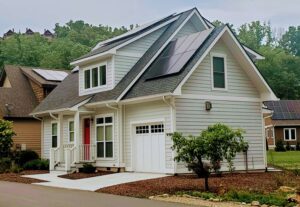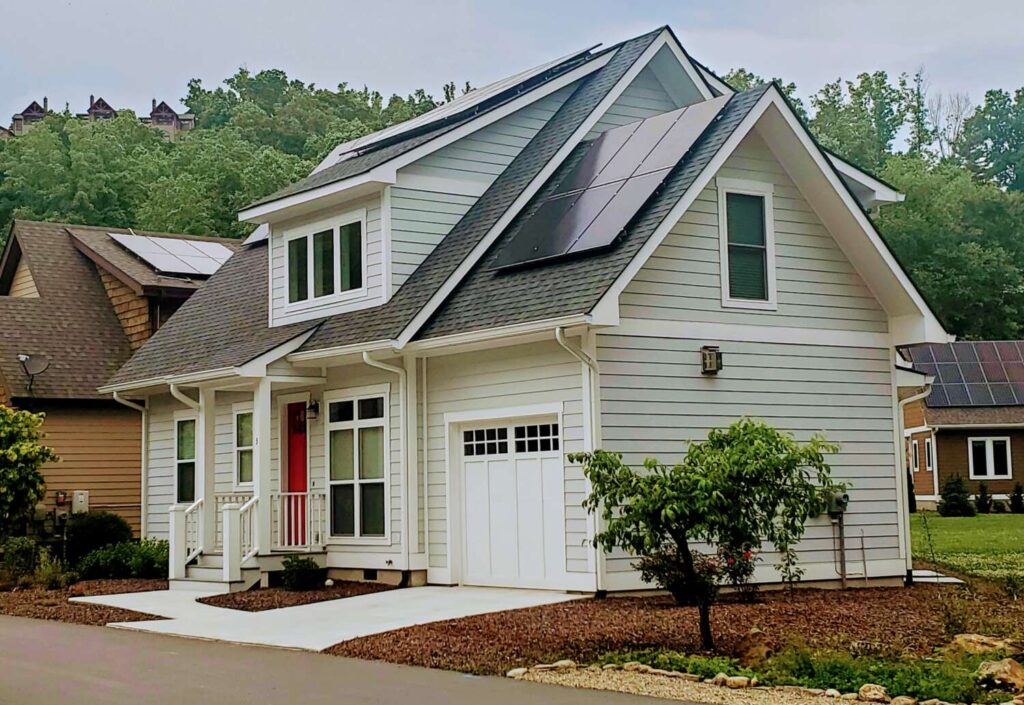As builders, we occasionally have to explain the benefits of constructing a Green Built Home to our clients. But when Peter and Diane Burkard approached us about building their new house, they already knew they wanted to build green.
“I didn’t have to sell them on it,” said Zach Banks, owner of Corner Rock Building Co. “They were already on board. It just fit with who they are.”
Peter and Diane weren’t particularly focused on the scorecard. They wanted their new house to reflect their environmental values, and Peter was hoping they would earn a gold-level certification from the Green Built Homes program.

Happily, their home did indeed earn gold-level certification. When they learned they had also attained a net-zero certification, they were delighted. But when they learned their home ranked in the top 10 highest scoring projects for Green Built Homes in 2020, all they could say was one word: “Wow!”
The Burkards’ home is located in The Villages at Crest Mountain in Asheville. Neighborhood features such as small lot sizes and community gardens counted towards Peter and Diane’s high sustainability rating. Most of the homes built in their community are certified through Green Built Homes, and many have earned fantastic scores. Even so, it was something special for this project to attain Green Built Homes’ Gold Net Zero level of certification.
The item that earned them the most points on the Green Built Homes checklist was their rooftop solar photovoltaic system. But solar alone didn’t set this house apart. Interestingly, it wasn’t any single component of the house that pushed their score so high. Rather, it was expertise and lots of little details that made the difference.
The Burkards wanted to find a builder with experience in eco-friendly building.
“We let Zach know what our desires were, and he just took the ball and ran with it,” Peter said.
Advanced framing techniques such as “California corners,” “sandwiched headers,” and 2×6 exterior walls were used to allow for better insulation and decrease the amount of energy a home consumes.
“As a default, we use several eco-friendly construction techniques on most of our houses, regardless of their participation in the program,” Banks said. “Green building just makes sense from a practical perspective. There are a lot of little things you can do early in the construction process to make a home very energy efficient.”
Attics are notorious for energy leaks, so open-cell foam insulation was used in the roof deck and gable ends to create a tight seal. The rest of the house got the same attention to detail when it comes to energy efficiency.
“To get the house tighter, we do several things,” Banks said. “We caulk the bottom plate of the exterior wall to the subfloor. We use open-cell insulation behind any fixture that is against an exterior wall, such as a bathtub or fireplace. We tape the seams on structural sheathing, and we caulk and tape around windows when they are installed to make them air-tight.”
At our suggestion, the Burkards chose to install a very efficient HVAC system. The dual-fuel system uses the home’s solar-supplied electricity to run a high-efficiency heat pump for the bulk of the year. When the temps dip extremely low in the winter, a high-efficiency natural gas furnace kicks in to keep the house comfortable.
The builder wasn’t the only expert involved in achieving such an outstanding result. During the building process, the energy rater suggested some small changes that led to the big score.
“One of the suggestions was to up the R-value of the insulation in the floors and ceilings from R-19 to R-30 on this house,” Banks said.
The cost was negligible for the Burkards, but contributed greatly to the home’s phenomenal Home Energy Rating System (HERS) Score of 9. (By comparison, the average house score is 100.)
The bulk of the credit goes, of course, to the homeowners themselves. Peter and Diane selected all the appliances and finishes for their home with environmental responsibility in mind. A myriad of seemingly small decisions — ceiling fans, low-flow faucets, LED lights, eco-friendly paint and countertops, no carpet or exotic hardwood, a programmable thermostat, etc. — all added up. Another example can be found in their decision to hire a local blacksmith to create their beautiful stair railing, which added one single point to their score and a breathtaking focal point to their living room.
The Burkards enjoy very low utility bills because the house has produced more energy than it consumes since the day they moved in. Their typical monthly bill is around $16 — the utility company’s minimum. The solar panels should pay for themselves in only 12 years, and the Burkards think their home has already increased in resale value due to the fantastic Green Built Homes score.
Monumental efforts aren’t necessary to build sustainably. Peter and Diane’s house proves that little things really can make a big difference. When asked if they would recommend the Green Built Homes certification program to others, their response was once again just one word: “Absolutely!”
Jennifer Banks is a co-owner of Corner Rock Building Co., along with her husband Zach. As the director of special projects, her work is never monotonous. Jennifer loves to help clients build homes that are beautiful, comfortable and uncommon. Connect with Jennifer at cornerrockbuilding.com.
You can also view this article as it was originally published on page 20 of the 2021-22 edition of the directory.


